ISSN ONLINE(2319-8753)PRINT(2347-6710)
ISSN ONLINE(2319-8753)PRINT(2347-6710)
| R. Vaira Vignesh, M. Pradeep and A. Sridharan Department of Mechanical Engineering, Karpagam College of Engineering (Autonomous), Coimbatore, India |
| Related article at Pubmed, Scholar Google |
Visit for more related articles at International Journal of Innovative Research in Science, Engineering and Technology
Nano composite metal is produced by introducing the nano phase material in the metal matrix of metal or an alloy. The unique property of the nano phase materials is their high surface area. The high surface area and surface dominant characteristics tend to be more reactive with the metal matrix. The least expensive method for synthesis and processing of Metal Matrix Nano Composite is solidification processing. As the nano phase materials tend to agglomerate, the rapid solidification method results in unordered metal matrix (nano size grains and amorphous metal from which nano phase reinforcements precipitate from amorphous matrix). The second method of mixing the nano reinforcements in the metal in liquid state followed by solidification process is convenient method of production of metal matrix nano composite. The Carbon Nano Tube reinforcement and Nano phase Carbon introduction to the molten metal matrix of AISI 1330 steel may result in enhanced physical, chemical and mechanical properties. The paper deals with a comparative analysis in the properties of MMNC – AISI 1330.
Keywords |
| Composite metal, Metal matrix, Carbon Nano Tube, Nano phase Carbon, Reinforcement, Solidification process |
INTRODUCTION |
| The photocopiers make use of toner to form images and text on the paper. The document is scanned and latent electrical image is formed over the drum. Then toner is sprayed over the drum. [1] The inability of the paper to grasp the complete toner particles when it slides over the drum results in sedimentation of toner over the surface of the drum roller. This left over toner known as waste toner is cleaned by the cleaning unit and deposited in the cleaner sump. The waste toner is neither recycled nor reused because of its inefficiency to produce quality print. |
| Dumping of waste toner in the land causes adverse effects the environment. The waste toner is neither recycled nor reused and it is simply dumped in the landfills. [2] This method of reusing the waste toner reduces the impact of adverse effects made by dumping of waste toner. |
TONER |
| Toner is a dense, powdery substance with carbon black as its major proportion.[3] The thermal properties of the toner should be soft for the fuser to bind and hard enough so that the toner particles are not fused in the photoreceptor at the developmental stage. The rheological properties of the toner must allow coalescence, spreading and finally penetration into the paper for best photo copy. [4] Rheology is the study of flow and deformation of materials under applied forces. The measurement of rheological properties is applicable to all materials – from fluids such as dilute solutions of polymers and surfactants through to concentrated protein formulations, to semi-solids such as pastes and creams, to molten or solid polymers. [5], [6], [7] Most of the photocopiers work on xerographic technique. [8] |
WASTE TONER |
| The toner is used in photocopiers to form the latent electrical image on the drum. The paper picks up the toner particles (image), when it slides over the drum. Nearly 10% of toner particles are left over the drum for a normal document. [9] The quantity of waste toner produced depends upon the usage of toner and the inability of the paper to grasp complete toner particles from the drum. |
| The waste toner cannot be used for further photocopying, as it does not satisfy the chemical properties and the quality of original toner. The waste toner is hazardous [10ÃÂÞÃâÃËÃÂøÃÂñÃÂúÃÂð! ÃÂÃËÃâÃÂÃâÃâÃÂþÃâÃâ¡ÃÂýÃÂøÃÂú ÃâÃÂÃâÃÂÃâÃâ¹ÃÂûÃÂúÃÂø ÃÂýÃÂõ ÃÂýÃÂðÃÂùÃÂôÃÂõÃÂý.], [11], [12]and has to be recycled. This waste toner is cleaned by the cleaning unit and it is collected in waste toner collector unit or cleaner sump. The quantity of waste toner produced depends upon the usage of toner and the inability of the paper to grasp complete toner particles from the drum. |
EXISTING SYSTEM |
| The Hybrid Black Toner is prepared using the original toner, waste toner and Carbon Black Nano powder. The original toner and the waste toner are mixed in the ratio and Carbon Black Nano powder is added to the above mixture. This composition is made to obtain a homogeneous mixture. The mixture has to be sintered at 413K for about 2 hours obtain the rheological properties. The original toner is added in proportion to maintain the fusing properties of the hybrid black toner. |
OPTIMIZATION |
| In the simplest case, an optimization problem consists of maximizing or minimizing a real function by systematically choosing input values from within an allowed set and computing the value of the function. The generalization of optimization theory and techniques to other formulations comprises a large area of applied mathematics. The existing system has to be optimized for efficient use of waste toner. |
| Single Variable Optimization Algorithms is used to solve minimization problems of the following type - maximise f(x), where f(x) is the objective function and x is a real variable. Here, x denotes the percentage of Carbon Nano Powder to be included for Hybrid Black Toner for optimized output and f(x) denotes the quality (in terms of percentage) of the photocopies The purpose of an optimization algorithm is to find a solution x, for which the function f(x) is maximum. |
CURVE EQUATION |
| Let y be the required equation and x be the variable. |
 |
CURVE ANALYSIS |
| Considering the maximum possible efficiency of the machine as 90% and this possible efficiency is achieved by 0.1% of Carbon Black Nano Powder (assumption), the curve can be analysed as follows. By trial method, introducing f(x) as x0.5, the Equation. 2 becomes |
 |
| Where „kâÃâ¬ÃŸ is the constant introduced. |
| When x = 0.1 and f(x) = 0.9 |
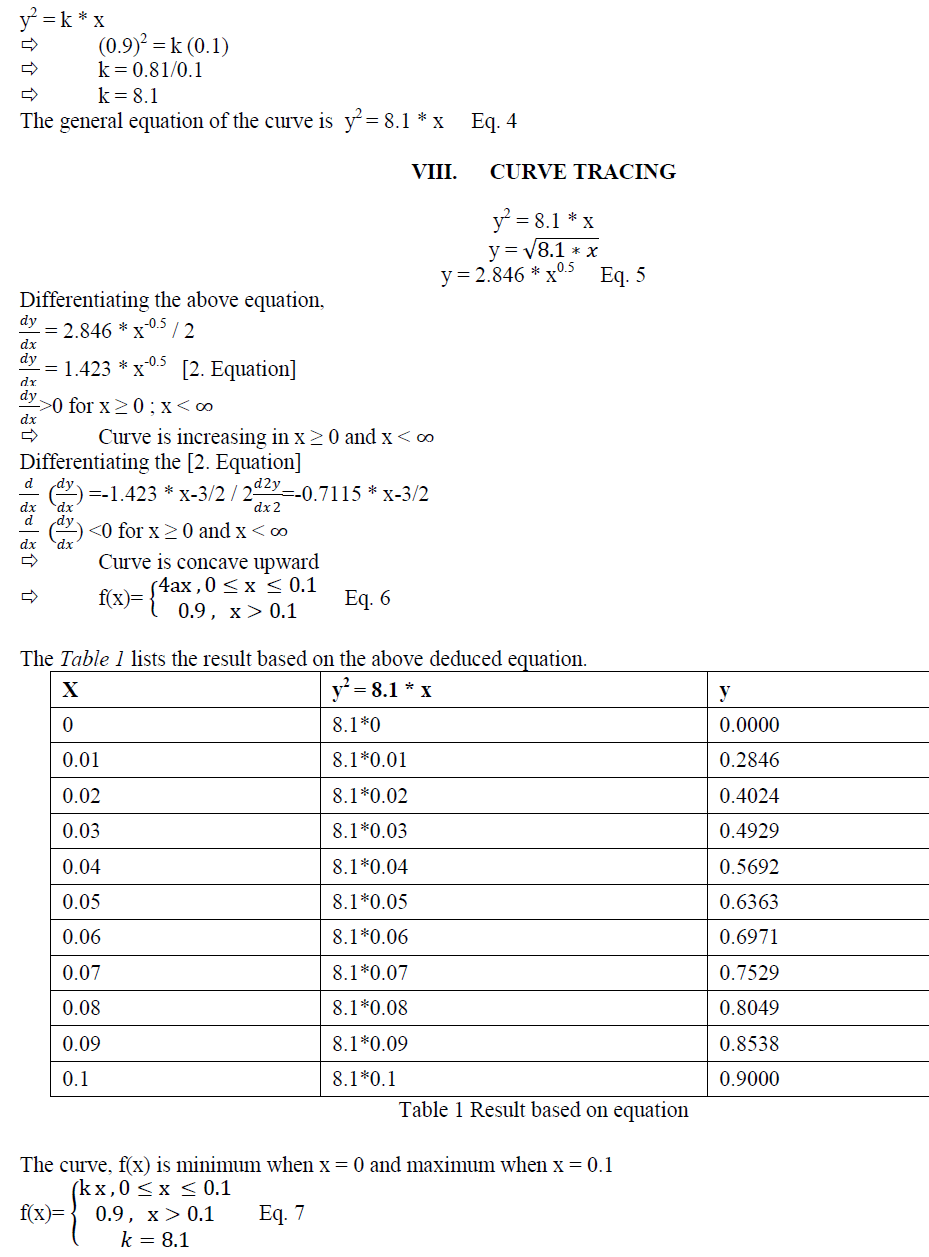 |
SYNTHESIS OF HYBRID BLACK TONER |
| The Hybrid Black Toner is prepared using the original toner, waste toner and Carbon Black Nano powder. The original toner and the waste toner are mixed in the ratio 20:79.9. Zero point one percent of Carbon Black Nano powder is added to the above mixture. This composition is made to obtain a homogeneous mixture. |
| The original toner is added in proportion to maintain the fusing properties of the Hybrid Black Toner. So the overall composition of Hybrid Black Toner is as follows: |
| 1. 79.9% of Waste toner |
| 2. 0.1% of Carbon Black Nano powder |
| 3. 20% of Original toner |
SEM ANALYSIS |
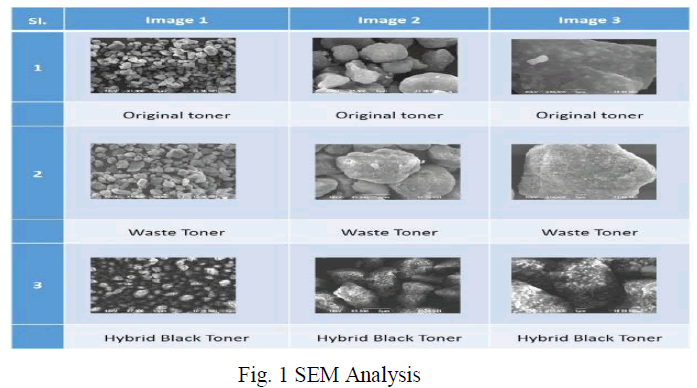 |
EDAX ANALYSIS |
| The composition of the Hybrid Black Toner is given in ÃÂÞÃâÃËÃÂøÃÂñÃÂúÃÂð! ÃÂÃËÃâÃÂÃâÃâÃÂþÃâÃâ¡ÃÂýÃÂøÃÂú ÃâÃÂÃâÃÂÃâÃâ¹ÃÂûÃÂúÃÂø ÃÂýÃÂõ ÃÂýÃÂðÃÂùÃÂôÃÂõÃÂý.Table. 2 as per the information obtained from the EDAX analysis as shown in the Fig. 2 |
| 1. Spectrum processing: |
| a. Peaks possibly omitted: 4.521, 8.016 keV |
| 2. Processing option: |
| a. All elements analyzed (Normalized) |
| b. Number of Iterations: 5 |
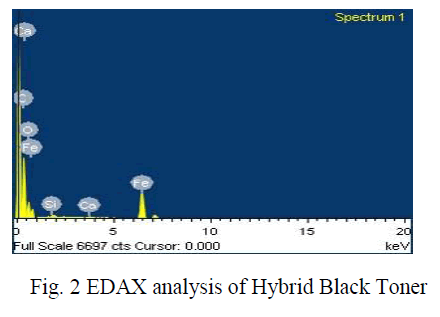 |
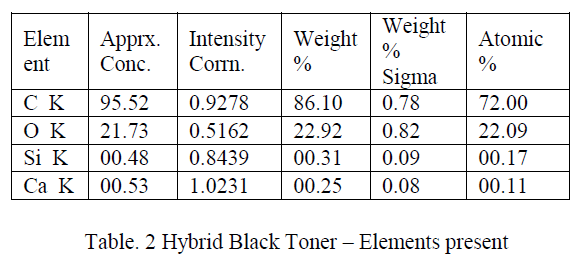 |
TEST RESULTS |
| The photocopies taken using the toner and their corresponding scanned documents are as shown in the Fig. 3ÃÂÞÃâÃËÃÂøÃÂñÃÂúÃÂð! ÃÂÃËÃâÃÂÃâÃâÃÂþÃâÃâ¡ÃÂýÃÂøÃÂú ÃâÃÂÃâÃÂÃâÃâ¹ÃÂûÃÂúÃÂø ÃÂýÃÂõ ÃÂýÃÂðÃÂùÃÂôÃÂõÃÂý. and Fig. 5. The test results are compared with the result obtained from the research article [9] and a survey has been taken from various professionals, students and public. |
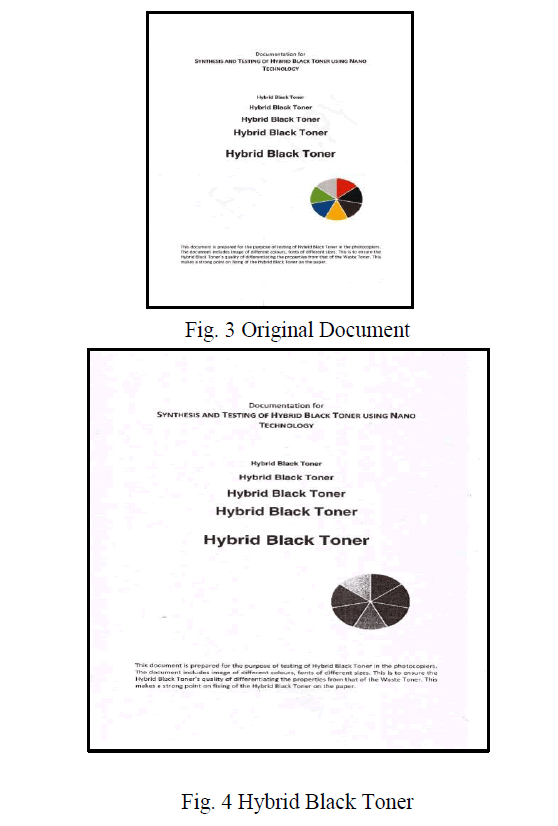 |
COMPARISON – TEST RESULT VS EQUATION RESULT |
| The equation result has been taken from the Table. 1 ÃÂÞÃâÃËÃÂøÃÂñÃÂúÃÂð! ÃÂÃËÃâÃÂÃâÃâÃÂþÃâÃâ¡ÃÂýÃÂøÃÂú ÃâÃÂÃâÃÂÃâÃâ¹ÃÂûÃÂúÃÂø ÃÂýÃÂõ ÃÂýÃÂðÃÂùÃÂôÃÂõÃÂý.and test result from the research article [9]. |
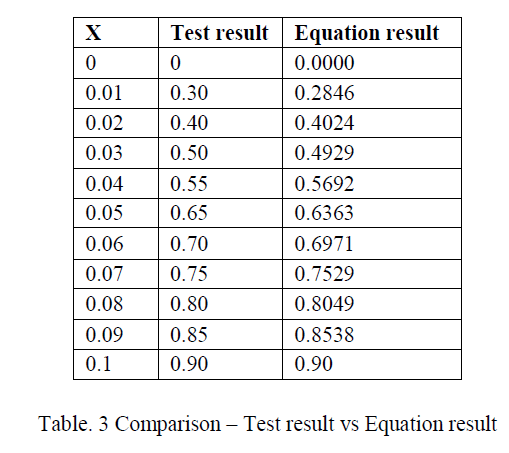 |
CONCLUSION |
| The Carbon Black Nano Powder addition to waste toner in considerable amount with that of original toner in the ratio of 0.1:79.9:20 is sufficient to form Hybrid Black Toner which has been optimised using Single Variable Algorithm Optimization technique. From the results of ÃÂÞÃâÃËÃÂøÃÂñÃÂúÃÂð! ÃÂÃËÃâÃÂÃâÃâÃÂþÃâÃâ¡ÃÂýÃÂøÃÂú ÃâÃÂÃâÃÂÃâÃâ¹ÃÂûÃÂúÃÂø ÃÂýÃÂõ ÃÂýÃÂðÃÂùÃÂôÃÂõÃÂý. and ÃÂÞÃâÃËÃÂøÃÂñÃÂúÃÂð! ÃÂÃËÃâÃÂÃâÃâÃÂþÃâÃâ¡ÃÂýÃÂøÃÂú ÃâÃÂÃâÃÂÃâÃâ¹ÃÂûÃÂúÃÂø ÃÂýÃÂõ ÃÂýÃÂðÃÂùÃÂôÃÂõÃÂý., it can be strongly proved that the Hybrid Black Toner is capable of producing images effectively with respect to its original colour. Added to this, the depth of hybrid black toner in fonts is consistent with the depth of original toner in fonts. So it is practically applicable in the photocopiers. |
| The alternative use of waste toner as principal medium of copying is suggested. This Hybrid Black Toner qualities are consistent with that of original toner. So, it can be used as an alternative to the original toner. |
References |
|